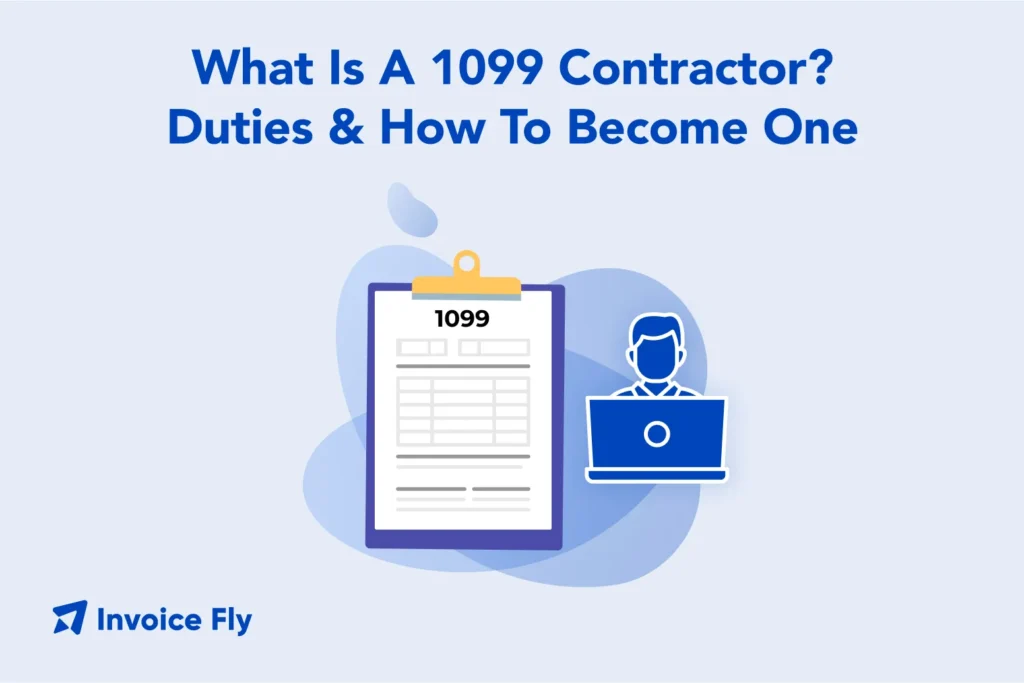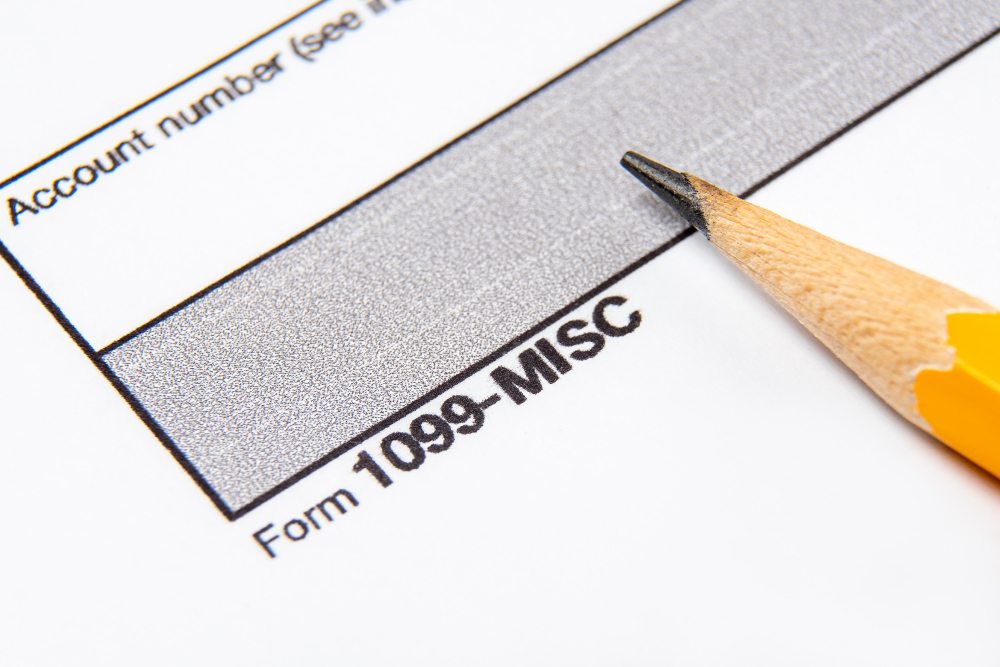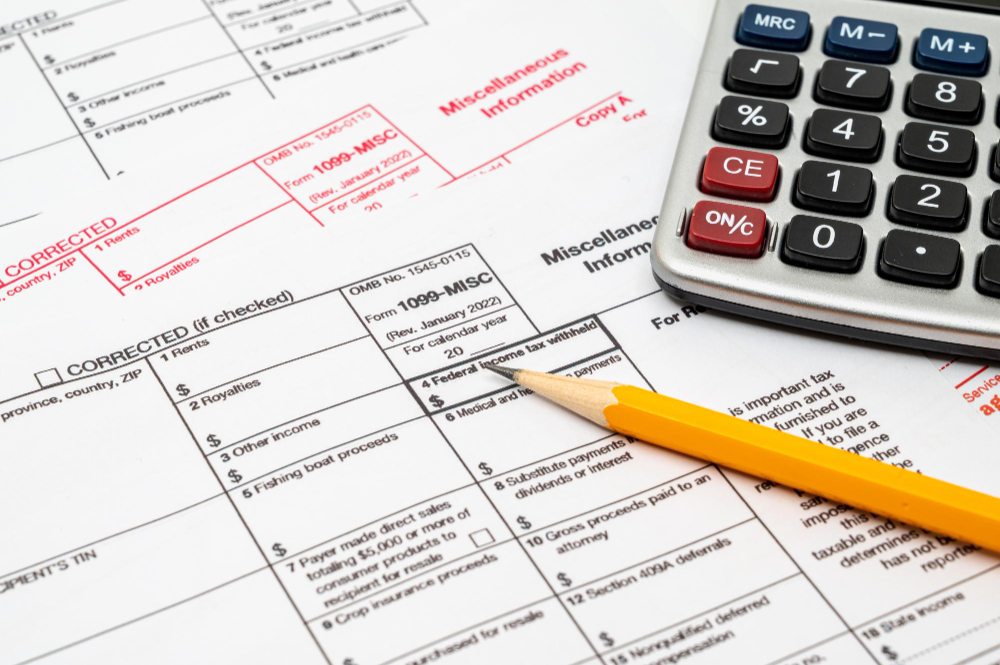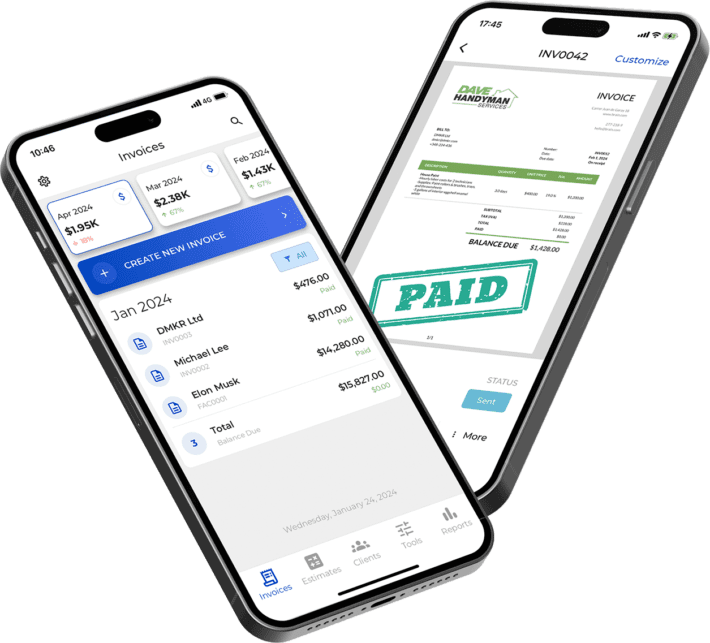What Is A 1099 Contractor? Duties & How To Become One

Table of Contents
If you work for yourself or get paid by different clients instead of one employer, you’re probably a 1099 contractor. These workers are also called independent contractors and they handle their own projects, contracts, and taxes. From freelance writers and designers to plumbers and construction workers, 1099 contractors get more freedom and control over their work, but they also take on more responsibility.
In this guide, we’ll break down what a 1099 contractor is, how they get paid, what taxes they need to file, and how you can become one.
Need tools to run your business better? Try Invoice Fly’s Business Reports to track performance and make smarter decisions!

What Is a 1099 Contractor?
A 1099 contractor, also called an independent contractor, is a self-employed person who provides services to clients or businesses without being an employee. The name comes from the 1099 form independent contractors receive at the end of the year showing their earnings.
According to the IRS definition of independent contractors, people such as doctors, dentists, veterinarians, lawyers, accountants, contractors, subcontractors, public stenographers, or auctioneers who are in an independent trade, business, or profession in which they offer their services to the general public are generally independent contractors.
The key difference between a 1099 contractor and an employee comes down to control. The IRS states that an individual is an independent contractor if the person for whom the services are performed has the right to control or direct only the result of the work—not what will be done and how it will be done.
For example, if you hire someone to build a deck and you tell them what the finished deck should look like, but they decide how to build it, what tools to use, and when to work, that person is likely an independent contractor. If you tell them exactly how to do each step and when to show up, they’re probably an employee.
Understanding whether you’re truly a 1099 independent contractor matters because it affects your taxes, benefits, and legal rights. The distinction isn’t always clear, which is why the IRS and Department of Labor have specific guidelines.
How Does a 1099 Contractor Work?
Independent contractors work differently from traditional employees in several important ways.
- Control and Independence: The general rule is that a 1099 contractor controls how they complete their work. They decide their methods, tools, and schedule. The client only controls the end result.
- Multiple Clients: Unlike employees who typically work for one employer, independent contractors often work with multiple clients at the same time. This diversification helps create steady income and reduces risk.
- Project-Based Work: Most 1099 contractors work on specific projects or contracts rather than ongoing employment. When the project ends, so does that working relationship—unless another project begins.
- Payment Structure: Independent contractors submit invoices for their work and get paid according to their contract terms. There’s no regular paycheck with taxes withheld. The IRS requires businesses to report payments to independent contractors on Form 1099-NEC when they pay $600 or more during the year.
- No Employee Benefits: Contractors don’t receive health insurance, paid time off, retirement contributions, or other employee benefits from clients. They’re responsible for securing their own benefits.
- Business Expenses: Independent contractors typically pay for their own tools, equipment, supplies, and other business expenses. These costs are usually tax-deductible.
Take Martin, a freelance electrician, who works regularly with five different clients. He decides which software to use and sets his own hours. Each client pays him per project, and he handles his own taxes and insurance. This arrangement makes her a 1099 contractor.
Common Duties and Responsibilities
Being a 1099 contractor means taking on responsibilities that employees don’t face. Here are the main duties:
Managing Own Schedule and Workload
Independent contractors have complete control over their schedules. This flexibility is great, but it also means you’re responsible for:
- Meeting all project deadlines without supervision
- Balancing multiple clients and projects simultaneously
- Determining how many hours to work and when
- Managing your own time off and vacation planning
Without a boss setting your schedule, you need strong self-discipline and organization skills to succeed.
Handling Taxes and Recordkeeping
Tax obligations represent one of the biggest responsibilities for 1099 contractors. Unlike employees who have taxes withheld from paychecks, contractors must handle everything themselves:
Self-Employment Tax: Independent contractors pay self-employment tax, which covers Social Security and Medicare. You can calculate self-employment tax using Schedule SE.
Quarterly Estimated Taxes: Most contractors need to pay estimated taxes for contractors four times per year to avoid penalties.
Recordkeeping: Keep detailed records of all income and expenses. You’ll need these when you file Schedule C with your tax return.
Income Reporting: Track income from all clients, including those who don’t send 1099 forms. You’re still required to report and pay taxes on all earnings.
Creating Invoices and Managing Payments
Getting paid requires professional systems and clear communication:
- Create detailed invoices that clearly state services provided, rates, and payment terms
- Follow up on late payments professionally
- Keep records of all payments received
- Write receipts of payment when clients pay
Using professional tools makes this process much easier. A free invoice template helps you create consistent, professional invoices, while an invoice maker can automate the entire billing process.

1099 Contractor Taxes Explained
Understanding your tax obligations as an independent contractor is crucial for avoiding penalties and maximizing deductions.
Self-Employment Tax: When you work as an independent contractor, your earnings are subject to self-employment tax. This covers Social Security and Medicare taxes that employers normally pay half of. As a self-employed person, you pay both halves—approximately 15.3% of your net earnings.
Income Tax: In addition to self-employment tax, you also pay regular income tax on your profits. The percentage of income for small business taxes varies based on your total income and tax bracket.
Quarterly Payments: The IRS expects you to pay taxes throughout the year, not just in April. Most 1099 contractors make quarterly estimated tax payments to avoid underpayment penalties.
Tax Forms: Key tax forms for independent contractors include:
- 1099-NEC: Clients send this form showing how much they paid you
- Schedule C: Where you report business income and expenses
- Schedule SE: Used to calculate self-employment tax
- Form 1040: Your individual tax return where everything comes together

Deductions: The good news? You can deduct many business expenses to reduce your taxable income. Common deductions include:
- Home office expenses
- Equipment and supplies
- Vehicle expenses for business use
- Professional development and training
- Business insurance premiums
- Marketing and advertising costs
Understanding the difference between 1099 vs W2 income helps you see why contractors need to set aside more money for taxes than employees do. If you work across state lines, you may also need to deal with multi-state income tax requirements.
Get Started with Invoice Fly’s Software
Invoice Fly is a smart, fast, and easy-to-use invoicing software designed for freelancers, contractors, and small business owners. Create and send invoices, track payments, and manage your business — all in one place.

How To Become a 1099 Contractor
Ready to start working as an independent contractor? Follow these steps to set yourself up for success:
- Choose Your Niche or Service
Decide what services you’ll offer based on your skills, experience, and market demand. Successful contractors typically specialize in specific areas like:
- Construction trades (plumbing, electrical, carpentry)
- Professional services (consulting, accounting, legal)
- Creative work (design, writing, photography)
- Technical services (IT support, web development, software)
The more specialized your skills, the more you can typically charge.
- Register Your Business
Depending on your location and industry, you may need to:
- Choose a business structure (sole proprietorship, LLC, etc.)
- Register your business name
- Get an Employer Identification Number (EIN) from the IRS
- Obtain any required independent contractor licenses
- Purchase necessary business insurance
Speaking of insurance, understanding what kind of insurance independent contractors need protects you from potential liabilities and losses.
- Set Up Contracts and Invoicing Tools
Professional contractors use written agreements and systematic billing:
Contracts: Create a standard 1099 contractor agreement template that includes:
- Scope of work and deliverables
- Payment terms and rates
- Project timeline
- Intellectual property rights
- Termination clauses
Invoicing System: Set up a reliable way to bill clients and track payments. Professional invoicing tools save time and ensure you get paid consistently.
Payment Processing: Decide how you’ll accept payments—check, ACH transfer, credit card, or payment platforms.
- Understand Your Tax Obligations
Before taking on your first client:
- Learn about self-employment tax and how it’s calculated
- Set up a system for tracking income and expenses
- Open a separate bank account for business finances
- Determine your quarterly estimated tax payment schedule
- Consider hiring an accountant or using tax software designed for self-employed individuals
Many contractors make the mistake of not setting aside enough money for taxes. A good rule of thumb is to save 25-30% of your gross income for taxes.
- Build Your Client Base and Reputation
Getting clients as a new independent contractor requires strategic effort:
Network: Tell everyone you know about your services. Many first clients come from personal connections.
Online Presence: Create a professional website and maintain active social media profiles in your industry.
Portfolio: Showcase your best work with samples, case studies, or testimonials.
Competitive Pricing: Use a service price calculator to set rates that cover your costs while remaining competitive.
Quality Work: Your reputation drives referrals. Deliver excellent work consistently, meet deadlines, and communicate professionally.
Follow Up: Stay in touch with past clients. Many contractors get repeat business from satisfied customers.

Pros and Cons of Being a 1099 Contractor
Like any career path, working as an independent contractor has advantages and disadvantages.
| Pros of Being a 1099 Contractor | Cons of Being a 1099 Contractor |
| Flexibility: Control your schedule, choose your clients, and decide how much to work. | No Job Security / Irregular Income: Clients can end contracts at any time. Income can fluctuate month to month. |
| Independence: Be your own boss and make business decisions. | No Benefits: You pay for your own health insurance, retirement, and time off. |
| Tax Deductions: Write off business expenses to reduce taxable income. | Higher Tax Burden: Pay both employer and employee portions of payroll taxes. |
| Earning Potential: No salary cap—you can raise rates and take on more projects. | Self-Discipline Required: No one manages your time or productivity. |
| Variety: Work with different clients on diverse projects. | Administrative Work: Handle all business tasks like invoicing, contracts, and bookkeeping. |
According to the Department of Labor, it’s important that workers are properly classified. Misclassification occurs when an employer treats a worker who is an employee under the Fair Labor Standards Act as an independent contractor. This is serious because misclassified employees may not receive minimum wage, overtime pay, and other protections they’re entitled to under the law.
Managing Your Finances as a 1099 Contractor
Success as an independent contractor requires strong financial management. Here are essential practices:
- Track Everything: Use accounting software or spreadsheets to monitor income, expenses, and taxes owed. Good records make tax time easier and help you understand your true profitability.
- Separate Business and Personal: Open dedicated business bank accounts and credit cards. This separation simplifies accounting and looks more professional.
- Know Your Take-Home Pay: Calculate your actual earnings after taxes and expenses. A salary calculator helps you understand your net income.
- Invoice Promptly: Send invoices as soon as work is complete. The faster you bill, the faster you get paid.
- Build an Emergency Fund: Save 3-6 months of expenses to cover slow periods or unexpected costs.
- Plan for Taxes: Set aside money for taxes with every payment you receive. Don’t wait until tax time to think about your obligations.
Final Thoughts
Becoming a 1099 contractor offers freedom and flexibility that traditional employment can’t match. You control your schedule, choose your clients, and have unlimited earning potential. However, this independence comes with responsibilities—managing your own taxes, finding clients, handling invoices, and securing your own benefits.
Success as an independent contractor requires planning, organization, and professional systems. Use written contracts, track your finances carefully, understand your tax obligations, and invest in tools that make running your business easier.
Whether you’re just starting out or looking to optimize your existing contracting business, the right preparation makes all the difference. Take time to understand the legal requirements, set up professional systems, and build a strong reputation in your field.Ready to streamline your contracting business? Start with professional invoicing using a free invoice template, or upgrade to an automated invoice maker that tracks payments and saves you time.
Get Started with Invoice Fly’s Software
Invoice Fly is a smart, fast, and easy-to-use invoicing software designed for freelancers, contractors, and small business owners. Create and send invoices, track payments, and manage your business — all in one place.

1099 Contractor FAQs
It depends on your priorities and situation. Being a 1099 contractor is worth it if you value flexibility, independence, and the potential to earn more by taking on multiple clients. However, it's not ideal if you need the stability of regular paychecks, employer-provided health insurance, or other employee benefits. Consider your financial situation, risk tolerance, and career goals before making the switch.
1099 contractors typically submit invoices to clients for completed work. Payment methods vary but commonly include checks, bank transfers (ACH), credit cards, or online payment platforms. Payment terms are usually net 15, net 30, or net 60 days, meaning the client has that many days to pay after receiving the invoice. Unlike employees, contractors don't receive regular paychecks with taxes withheld—they receive the full amount and handle taxes themselves.
The term "1099 employee" is actually a misnomer—1099 workers are contractors, not employees. There's no legal limit on how many hours an independent contractor can work. However, if you're working full-time hours exclusively for one client who controls when and how you work, the IRS might determine you're actually an employee being misclassified. To learn more about this distinction, read about what is a 1099 employee and the proper classification rules.
Protect yourself by: (1) Using written contracts for every project that clearly outline scope, payment terms, and expectations; (2) Getting appropriate business insurance to cover liability and other risks; (3) Keeping detailed records of all work, communications, and payments; (4) Setting aside money for taxes regularly; (5) Understanding your rights and the difference between contractor and employee status according to IRS guidelines; and (6) Getting paid upfront or using deposits for large projects.
In terms of percentage, yes—1099 contractors typically pay more in taxes than W-2 employees because they pay both the employee and employer portions of Social Security and Medicare taxes (self-employment tax). However, contractors can deduct many business expenses that employees cannot, which can reduce their taxable income significantly. The actual tax burden depends on your income level, deductions, and whether you understand how to calculate your gross income and optimize your tax strategy.
